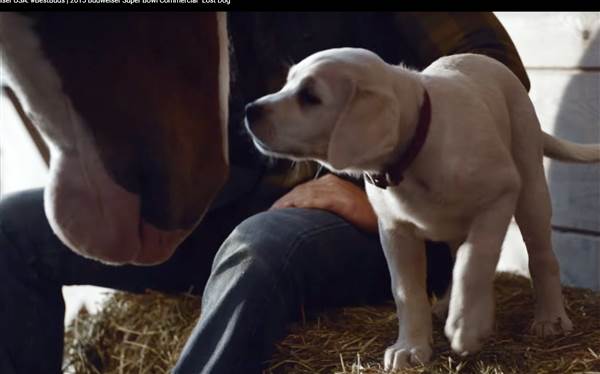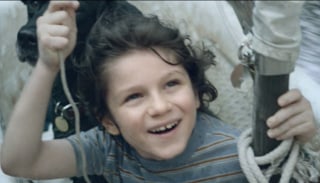
No kids talking from beyond the grave. No lost puppies cowering in the rain. Advertisers paying through the nose for spots during Super Bowl 50 are expected to play it safe and stress positive or uplifting themes this year, industry observers say.
“Last year (was) much more emotional … compared to funny. It almost got to a point where people were like, enough, already,” said Peter Daboll, CEO of ad analytics firm Ace Metrix, referring to dark ads from several prominent brands that aired during Super Bowl XLIX. “There was a fair amount of consumer backlash.”
Michael Bernacchi, a marketing professor at the University of Detroit Mercy, agreed that the negative response to several of last year’s Super Bowl ads will be fresh in advertisers’ minds.
“I expect joviality, optimism — I expect comedic ads, I expect lightheartedness,” he said.

Most of the negative commentary last year focused on two spots: A Budweiser ad featuring a wet, muddy Golden Retriever puppy being rescued from wolves by the brand’s Clydesdale mascots. Budweiser, a Super Bowl advertising mainstay, hasn’t tipped what it has in store this year, but said it’s not bringing back the pooch.
Reaction was even stronger to an ad narrated by a young boy talking about all the things he didn’t get to do in life — because he died in a childhood accident.
Super Bowl Ads Left Us Creeped Out Or Crying
The “dead kid” commercial, an attempt by Nationwide Insurance to promote an accident-prevention initiative, was widely panned and may have cost the insurer business. On social media, users complained that their kids were scared by the commercial or that it made them relive their own painful memories of losing a child.

Market research firm RealityMine said that more than 10 percent of people who saw the ad said they wouldn’t buy insurance from Nationwide as a result.
“Compared to all other commercials seen by Super Bowl viewers, Nationwide’s ad had the most negative impact on purchase intent,” the company said in a report.
With economical, geopolitical and cultural strife also in the news, advertisers are anticipating the audience this year will have little tolerance for ads that conjure up even a whiff of controversy.
“There’s so much scrutiny,” said Tim Calkins, a clinical professor of marketing at Northwestern University’s Kellogg School of Management. “You want to stand out, but at the same time, you have to be safe.
“It’s partly financial risk. It’s also creative risk. Advertisers are very nervous about offending people. There are a lot of topics advertisers will work very hard to stay away from (because) there’s a lot of tough stuff going on in the world right now.”
So sensitive are brands that Bernacchi said some will likely eschew football-themed ads on the National Football League’s biggest day, given the league’s recent PR fumbles on issues like concussion-induced brain trauma and domestic violence.
“I think, really, this particular Super Bowl in its ads wants to separate from that as much as they possibly can,” he said.
E-Cigarette Ads Target Millions of Kids, CDC Says
“Even the movies (ads) that are likely to be shown fit into that glove of positivism, of optimism,” Bernacchi said, suggesting that trailers for superhero films could be studios’ promotions of choice during the commercials.
A misstep during the Super Bowl can cost more than brand equity, since commercial slots during the game are more expensive than ever.
The cost of a Super Bowl commercial has gone up by 76 percent, on average, over the past decade, according to Kantar Media. Last year, 30-second commercials
cost around $4.4 million, a number that’s closer to $5 million this year, even with what chief research officer Jon Swallen called “a near-record amount of commercial time.”
Year after year, marketers ask when Super Bowl commercial prices are going to climb beyond what brands are willing to pay. The answer this year, as in every previous year, is “not yet.”
The escalating cost means that more companies are approaching the Super Bowl almost like the tentpole of a franchise rather than a one-off ad.
“More and more, the spot is one component of a multifaceted, multiplatform, longer-term engagement,” said Mitch Germann, senior vice president and senior partner at FleishmanHillard. “Often the conversation is now starting before the game through social activation or some kind of teaser content. I think it goes back to, instead of having one moment in time, having a longer story.”
Releasing ads online ahead of time, a common practice for a few years, seems to be dying out. In its place are more elaborate, participatory campaigns that begin a couple of weeks before game day and which advertisers hope will provide momentum to propel their brand messages forward during the game.
“We’re absolutely counting on a multi-screen experience,” said Jamie Tedford, founder and CEO of social marketing company Brand Networks. Just within the past year, Facebook ads have hit a tipping point, with more views on mobile devices than desktop computers, he said, and this is shaping how marketers plan their strategies.
“What we’re anticipating is storytelling increasing in its importance and, in some cases, teasing a story on broadcast that picks up and goes deeper online,” he said.
Germann, the FleishmanHillard, said that means advertisers will be trying to connect with viewers in multiple ways during the game.
“So many fans are activating second and third screens,” he said, predicting the use of participatory elements like contests or voting to coax viewers into liking, Tweeting or otherwise tuning into their social platforms while watching the game.
“One thing that we expect to see an increase in this year is more participatory storytelling where the ad is asking fans to take some kind of action. It’s less about one canned statement and more about having a real time conversation.”
[Source:- nbcnews]

